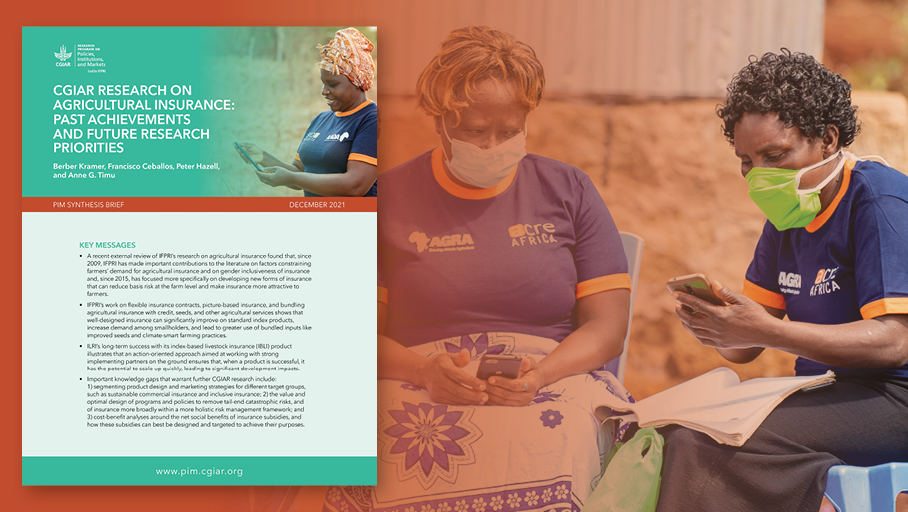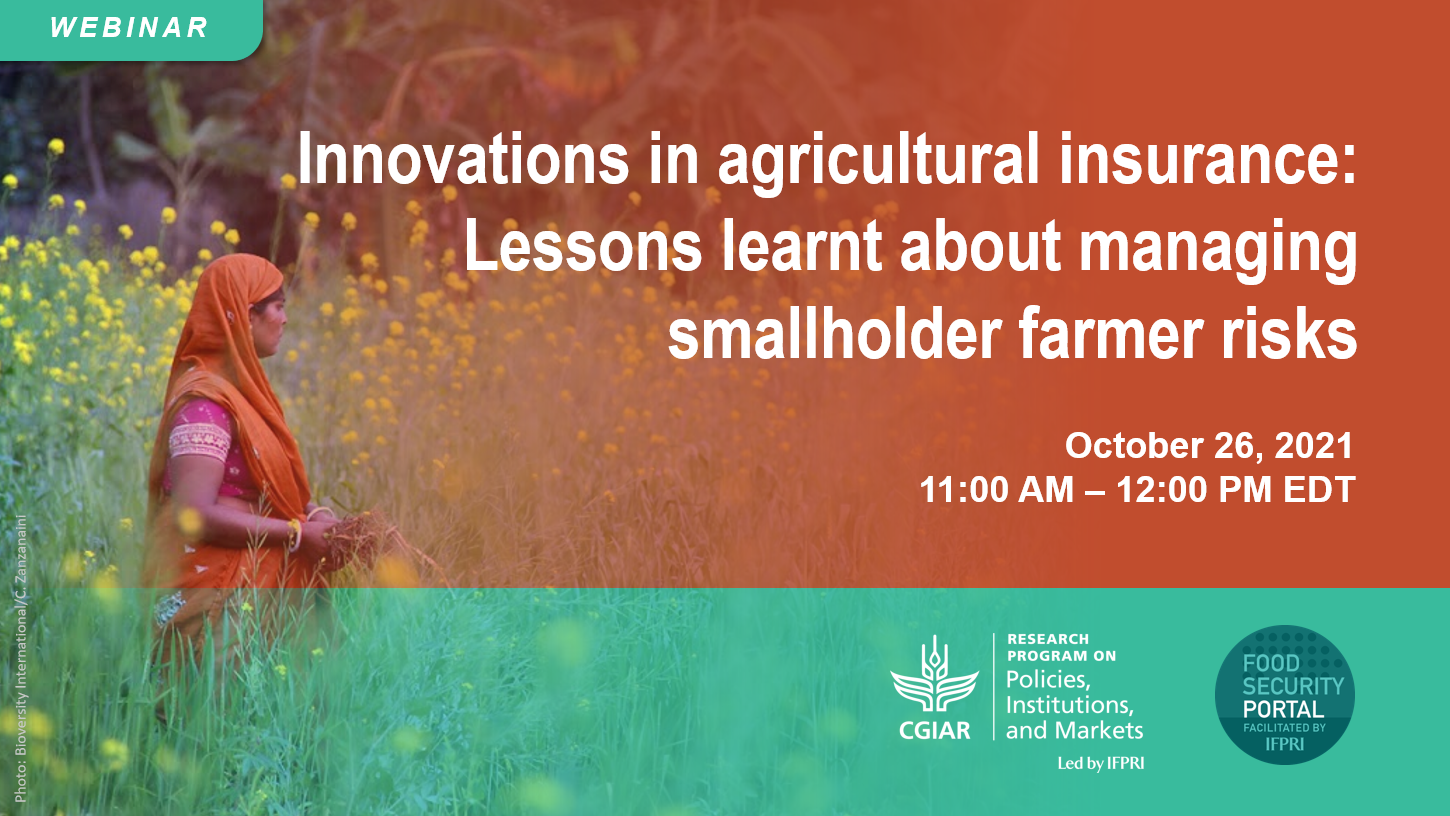Since 2009, the CGIAR Research Program on Policies, Institutions, and Markets (PIM), led by the International Food Policy Research Institute (IFPRI), has been undertaking research on innovations in agricultural insurance to improve smallholder farmers' adaptation to climate change. Initial randomized controlled trials (RCTs) around weather index insurance (WII) in Bangladesh, Ethiopia, India, and Uruguay largely sought to understand why smallholders were reluctant to purchase agricultural insurance. These studies highlighted the need for innovations in product design to increase demand to sustainable levels. The research teams started to test flexible forms of WII products (giving farmers a menu of insurance units to mix and match into their preferred composite index), gap insurance (allowing farmers to request an audit in case of losses for which WII does not trigger a payout), picture-based insurance (which settles insurance claims based on visible damage in smartphone pictures), and risk-contingent credit (bundling insurance with credit).
A recent evaluation (Hazell and Timu, 2021) found that this research has made substantial scientific contributions, including an enhanced understanding of what works to increase insurance uptake, and how to strengthen product quality. The action-oriented nature of the work and piloting new approaches with implementing partners contributed to capacity development of partners in both public and private sector (including insurance and reinsurance firms, insurance aggregators, banks, microfinance institutions, agrovets and seed companies).
This blog summarizes the external review’s insights on how to create wider policy impacts with this type of research. We specifically seek to answer the following questions:
- which research approaches work best to promote scaling-up of the insurance programs?
- how can CGIAR research engage with insurance companies and other private sector actors, and identify which insurance approaches are attractive to them? and
- which research methods can CGIAR adopt to enhance our understanding of how to foster inclusivity in insurance?
Research findings having impact at scale
Having impact at scale through agricultural insurance research calls for innovations that address the challenges along the entire insurance and agricultural value chain. IFPRI’s research has primarily focused on innovations to strengthen product quality and increase demand, for instance through its work on picture-based insurance (to reduce basis risk), risk-contingent credit (to address liquidity constraints), and bundling with improved seeds (to increase access to profitable investment opportunities). The next step to have impact at scale is to integrate these various innovations to provide producers with more comprehensive risk coverage. This requires working with implementing partners who have a commercial interest in providing insurance. Identifying such partners and strengthening their capacity to scale up services after a research program ends requires longer-term engagements and funding commitments than what is currently in place for most agricultural insurance research programs. Longer-term arrangements would also enable researchers to conduct rigorous impact evaluations and cost-benefit analyses.
IFPRI’s experiences also highlight the need for partnering with the public sector to create an enabling environment, for instance in terms of regulations around new insurance products and providing temporary subsidies or piloting new approaches as part of national (subsidized) insurance schemes. Bringing in both public and private sector is an important direction for future research which could help generate rigorous experimental evidence on costs and benefits of public insurance subsidies to taxpayers, insurers, and insured beneficiaries.
Engaging with insurance companies and other actors
IFPRI’s experience shows that it is possible to do rigorous research, including experiments and RCTs, in partnership with private sector. Such collaborations help identify what makes participating in agricultural insurance schemes attractive for various intermediaries, not only the end-users. This is an important question to be studied in the future, which also calls for new research methods to complement the RCTs and other experimental approaches that IFPRI and partners have used so far.
Inclusive insurance models
IFPRI made deliberate efforts to collect sex-disaggregated data and reach women and the poor. This included, for example, equipping champion farmers (often female) with smartphones to test digitally based products accessible to farmers who do not own a smartphone, and designing marketing strategies targeting both women and men. However, this focus on gender equality in the reach of insurance has not been sufficient to bridge existing gender gaps in risk exposure and access to agricultural services. Future research should focus on evaluating how insurance benefits different groups of women and men, and how insurance programs can advance women’s empowerment or contribute to more equitable gender norms (Timu et al., forthcoming).
Conclusion
Several research initiatives proposed under One CGIAR include components on agricultural insurance. Drawing from a decade of work in the insurance value chains in the developing countries, we believe that the following methods and strategies can amplify impacts of the future research:
- Work toward the development of more comprehensive insurance products that can address both demand and supply-side constraints.
- Work closely with the public sector to support program scaling and finance subsidies, with rigorous empirical methods informing cost-benefit analyses of public investments.
- Establish longer-term research programs, with long term funding, to conduct rigorous impact studies, and to build partners’ capacity to scale insurance.
- Adopt different research methods to understand interest in providing agricultural risk management solutions among insurers and intermediaries.
- Move from gender-inclusive to gender-responsive and -transformative approaches to increase impact on gender equity, women’s empowerment, and social inclusion.
To learn more about PIM work on agricultural insurance, please check these recent synthesis brief and webinar:
 Kramer, Berber; Ceballos, Francisco; Hazell, Peter; and Timu, Anne G. 2021. CGIAR research on agricultural insurance: Past achievements and future research priorities. PIM Synthesis Brief December 2021. Washington, DC: International Food Policy Research Institute (IFPRI). https://doi.org/10.2499/p15738coll2.134903
Kramer, Berber; Ceballos, Francisco; Hazell, Peter; and Timu, Anne G. 2021. CGIAR research on agricultural insurance: Past achievements and future research priorities. PIM Synthesis Brief December 2021. Washington, DC: International Food Policy Research Institute (IFPRI). https://doi.org/10.2499/p15738coll2.134903
 Innovations in agricultural insurance: Lessons learnt about managing smallholder farmer risks. PIM Webinar, October 26, 2021. Presenters: Peter Hazell, Research Fellow Emeritus, IFPRI; Anne G.Timu, Economist, University of Nebraska-Lincoln; Berber Kramer, Senior Research Fellow, IFPRI
Innovations in agricultural insurance: Lessons learnt about managing smallholder farmer risks. PIM Webinar, October 26, 2021. Presenters: Peter Hazell, Research Fellow Emeritus, IFPRI; Anne G.Timu, Economist, University of Nebraska-Lincoln; Berber Kramer, Senior Research Fellow, IFPRI
More news from Flagship 3: Inclusive and Efficient Value Chains



